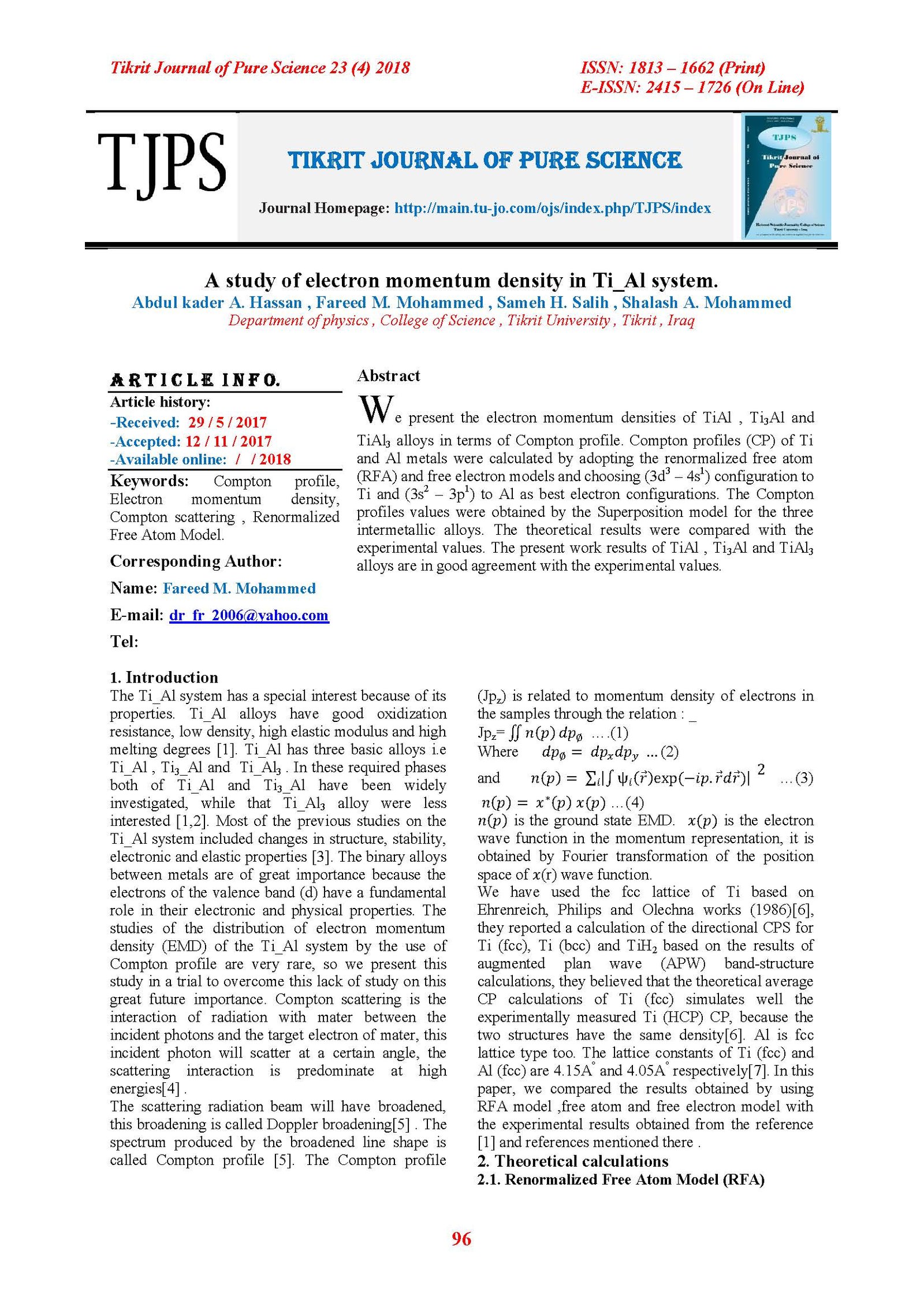A study of electron momentum density in Ti_Al system.
Main Article Content
Abstract
We present the electron momentum densities of TiAl , Ti3Al and TiAl3 alloys in terms of Compton profile. Compton profiles (CP) of Ti and Al metals were calculated by adopting the renormalized free atom (RFA) and free electron models and choosing (3d3 – 4s1) configuration to Ti and (3s2 – 3p1) to Al as best electron configurations. The Compton profiles values were obtained by the Superposition model for the three intermetallic alloys. The theoretical results were compared with the experimental values. The present work results of TiAl , Ti3Al and TiAl3 alloys are in good agreement with the experimental values.
Article Details

This work is licensed under a Creative Commons Attribution 4.0 International License.
Tikrit Journal of Pure Science is licensed under the Creative Commons Attribution 4.0 International License, which allows users to copy, create extracts, abstracts, and new works from the article, alter and revise the article, and make commercial use of the article (including reuse and/or resale of the article by commercial entities), provided the user gives appropriate credit (with a link to the formal publication through the relevant DOI), provides a link to the license, indicates if changes were made, and the licensor is not represented as endorsing the use made of the work. The authors hold the copyright for their published work on the Tikrit J. Pure Sci. website, while Tikrit J. Pure Sci. is responsible for appreciate citation of their work, which is released under CC-BY-4.0, enabling the unrestricted use, distribution, and reproduction of an article in any medium, provided that the original work is properly cited.
References
[1] G. Sharma, K.B. Joshi, M.S. Dhaka, M.C. Mishra, R.K. Kothari, B.K. Sharma, “Compton profile and charge transfer study in Ti_Al system”, Intermetallics, 19(2011)1107-1114.
[2] C. Angeles-Chavez, G. Rosas, R. Reyes-Gasga, ”Structural characteristics ofintermetallic
TieAleCu alloys”. ATM 2001;3:1-6.
[3] B.G. Williams; ”Compton scattering” McGraw Hill, New York (1977).
[4] G. Ahmed, Y. Sharma, B.L. Ahuja, “Electronic properties of PbCl2 andusing Compton scattering technique”, Applied Radiation and Isotopes 67 (2009) 1050–1056.
[5] B.L. Ahuja, G. Arorab, G. Ahmed, A. Rathor, V. Sharma, K. Kadas, R. Ahuja, ”A study of electron momentum density and charge transfer in W–Cu system”, Alloys and Compounds 467 (2009) 595–599.
[6] N.C. Bacalis, N.I. Papanicolaou and D.A. Papaconstantopoulos, J. Physc. F; Met. Phys.16, 1471-1483, (1986).
[7] S.K.Kim, F.Jona and P.M. Marcus. Journal of Physics: Condensed Matter, Volume 8, N. 1(1995).
[8] D. Paol and H.C. Padhi, phys. Stat. Col. (b)175, 507(1993).
[9] M. Chodorow, phys. Rev.55,675,(1939).
[10] L. Hodges, R.E. Watson, H. Ehrenreich, phys. Rev. b5, 3953(1972).
[11] C.D. Gelatt, H. Ehrenreich, R.E. Watson, bhys, Rev.b6, Vol.15, No.4, 1613-28 (1977).
[12] B. Chaddah and V.C. Sahni, Phil Mag.B37, 305(1978).
[13] N.A Ndersson,etil.,”Emission spectra of TIH and TID Near 938 nm“,Chem
phys.118:10543.(2003).
[14] M.J. Cooper, Rep.prog.phys.48,415(1985) and reference Therein. Also M.J. Copper, P.E. Mijnarenas, N. Shiotani, N. Sakai and A. Bansil “x-ray Compton scattering” (Oxford University Prees, New York), (2004).
[15] L. Bigges, L.B, Mendelsohn and J.B. Mann, At. Data Nucl. DataTables16,201-309(1975).
